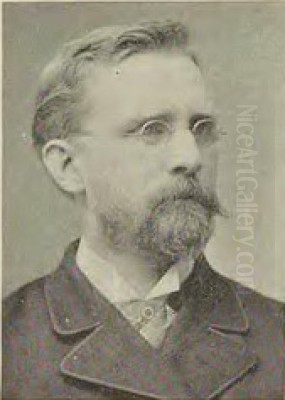
Thomas Bigelow Craig stands as a significant figure in late nineteenth and early twentieth-century American landscape painting. Born in Philadelphia, Pennsylvania, in 1849, and passing away in 1924, Craig dedicated his artistic career to capturing the serene beauty of the American countryside, becoming particularly renowned for his depictions of cattle grazing peacefully in sunlit pastures and along tranquil streams. Though perhaps partially trained at the Pennsylvania Academy of the Fine Arts, he was largely considered a self-taught artist, developing a distinctive and popular style that resonated with the tastes of his time.
Early Life and Artistic Formation in Philadelphia
Thomas Bigelow Craig entered the world in Philadelphia, a city with a burgeoning artistic community. While records suggest he may have spent some time studying at the prestigious Pennsylvania Academy of the Fine Arts (PAFA), the consensus among art historians is that Craig primarily honed his skills through dedicated self-study and observation. This path was not uncommon for artists of the era, demanding discipline and a keen eye for the nuances of the natural world.
His artistic journey began in earnest around 1869, when he first started exhibiting his works, likely at PAFA. These early showings marked the beginning of a long and consistent career dedicated to landscape painting. Philadelphia provided a supportive environment, but Craig's aspirations and developing style would soon lead him to seek broader recognition.
Developing a Signature Style: The Pastoral Landscape
Craig quickly found his niche in pastoral landscapes, often imbued with a sense of peace and tranquility. His most characteristic works feature herds of cattle, and occasionally sheep, integrated seamlessly into idyllic settings. These scenes typically unfold under the warm glow of summer sunshine, illuminating lush meadows, gently flowing streams, and verdant trees. The atmosphere in his paintings is consistently calm and inviting, reflecting a romanticized view of rural life that appealed greatly to audiences weary of industrialization.
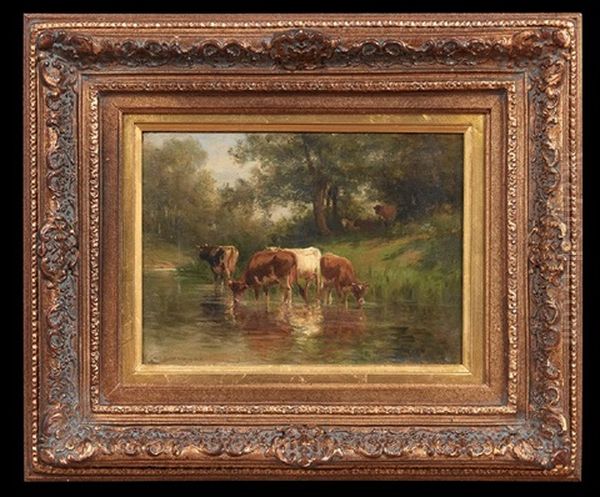
His approach evolved over time. Early compositions might feature the animals as smaller elements within a broader landscape, but as his career progressed, the cattle often became more central, rendered with careful attention to their form and posture, yet always remaining in harmony with their surroundings. This focus on domesticated animals within a specific type of landscape became his hallmark.
Echoes of Barbizon in America
Craig's artistic sensibilities align closely with the American Barbizon School, a movement inspired by the French Barbizon painters like Jean-François Millet and Théodore Rousseau. These artists rejected the highly polished, academic styles, favoring instead more intimate, moody, and atmospheric depictions of rural landscapes and peasant life. In America, painters like George Inness, Alexander Helwig Wyant, and Homer Dodge Martin adapted these ideals to the American scene.
Craig’s work embodies many Barbizon characteristics: a focus on capturing specific light effects and atmospheric conditions, a preference for tonal harmony over sharp detail in all areas, and an emphasis on the quiet poetry of the everyday rural landscape. Unlike the grand, often dramatic vistas of the earlier Hudson River School painters, Craig, like his Barbizon-influenced contemporaries, sought beauty in simpler, more intimate corners of nature.
Mastery of the Bovine Subject
The depiction of cattle was central to Craig's art and popularity. He developed considerable skill in rendering these animals, capturing their placid nature and the way their forms interacted with light and shadow. His approach differed from artists like Arthur Fitzwilliam Tait, who was renowned for his more dramatic and detailed paintings of wildlife and sporting scenes. Craig's cattle are typically shown resting, grazing, or wading, contributing to the overall serenity of the composition.
His focus on this subject matter placed him in the company of other prominent American artists known for their cattle paintings, most notably William Hart and James M. Hart. These brothers, associated with the later Hudson River School, also frequently incorporated cattle into their luminous landscapes. While there is no record of direct collaboration, Craig worked within a similar thematic vein, contributing significantly to this popular genre of American painting.
Building a National Reputation Through Exhibitions
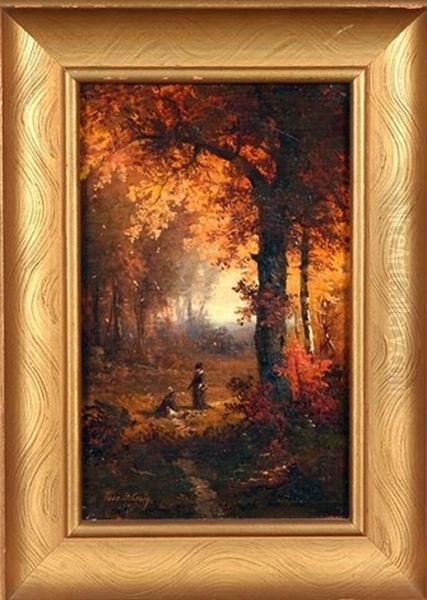
Craig actively sought to build his reputation beyond Philadelphia. He began exhibiting at the National Academy of Design (NAD) in New York City sporadically between 1879 and 1881. His connection with the NAD solidified after he moved to New York City in 1889. From that point forward, he became a regular and frequent exhibitor at the Academy's prestigious annual exhibitions for many years, with some sources stating his participation spanned an impressive 45 years in total.
The NAD exhibitions were crucial venues for artists seeking national recognition and patronage. Craig's consistent presence there indicates the positive reception of his work within the established art circles of the time. His paintings found favor with collectors who appreciated his gentle, naturalistic style.
Recognition, Memberships, and Further Exhibitions
Craig's growing stature was formally recognized in 1897 when he was elected an Associate National Academician (ANA) by the National Academy of Design. This was a significant honor, confirming his standing among his peers. Beyond the NAD, Craig was active in other artistic organizations and exhibition venues.
He was a member of the Artists' Fund Society, an organization dedicated to supporting artists in need, and the Salmagundi Club in New York, a prominent social and artistic club. He also joined the Chicago Watercolor Club. His exhibition record was extensive, including regular showings at the Boston Art Club, the Brooklyn Art Association, and the Art Institute of Chicago, demonstrating his wide reach and acceptance in major art centers across the country.
Showcasing at the World's Columbian Exposition
A notable highlight in Craig's exhibition history was his participation in the World's Columbian Exposition held in Chicago in 1893. This grand international fair was a major cultural event, offering American artists an unparalleled platform to showcase their talents to a vast audience, both domestic and international. Inclusion in the Fine Arts exhibition at the Exposition was a mark of distinction, and Craig's presence there further cemented his national reputation.
The Exposition celebrated American progress and culture, and landscape painting held a prominent place. Craig's tranquil pastoral scenes represented an idealized vision of the American land that resonated with the themes of the fair.
Connections to the Hudson River School Tradition
While Craig's style is often linked more closely to the Barbizon influence due to its intimate scale and focus on mood, his work also shows connections to the legacy of the Hudson River School. This earlier movement, pioneered by artists like Thomas Cole and Asher B. Durand, emphasized detailed observation of nature and celebrated the unique beauty of the American landscape.
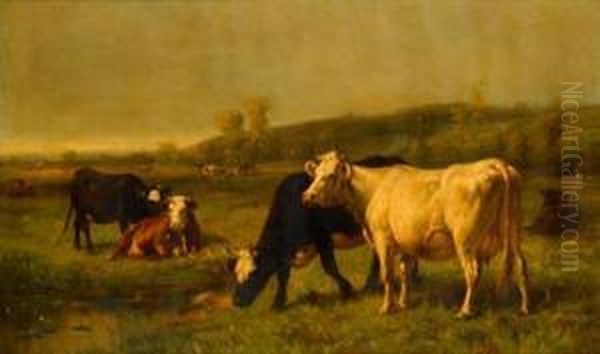
Craig continued this tradition of careful observation, particularly in his rendering of foliage, water, and the effects of light. Although he generally avoided the epic scale and dramatic wilderness scenes favored by painters like Albert Bierstadt or Frederic Edwin Church, his dedication to capturing specific American locales aligns with the Hudson River School's core tenets. His work can be seen as part of the evolution of this tradition, adapting its naturalism to quieter, more pastoral themes, much like later Hudson River figures such as Sanford Robinson Gifford or the aforementioned Hart brothers.
A Distinctive and Consistent Style
Throughout his long career, Thomas Bigelow Craig maintained a remarkably consistent style and subject matter. His paintings are readily identifiable by their characteristic features: a luminous, often warm light suggesting a summer day; carefully rendered details in the foreground foliage and water surfaces, often featuring reflections; and the ubiquitous presence of calmly grazing or resting cattle.
The overall mood is invariably one of peace and harmony between the animals and their environment. This consistency, while perhaps limiting in terms of artistic experimentation, contributed to his popularity. Collectors knew what to expect from a Craig painting: a well-executed, pleasing image of rural tranquility.
Representative Works
While a comprehensive list of his works is extensive, certain titles are often cited as representative of his output. The Watering Place, dated 1891, exemplifies his classic theme, likely depicting cattle gathered near a stream or pond, a common motif in his oeuvre. Another named work, In June Sunshine, evokes the bright, warm atmosphere that characterizes so many of his paintings.
Even without specific titles, his body of work consistently explores variations on his central theme: cattle in sun-dappled meadows, often near water, under blue summer skies or the soft light of late afternoon. These works collectively form a cohesive vision of an untroubled American countryside.
Life in Rutherford and Later Years
In 1899, Craig moved from New York City and settled in Rutherford, New Jersey. This location likely provided him with continued easy access to the sort of rural and semi-rural landscapes that inspired his work. He maintained a studio there and also had a summer studio in Woodland, New York, in the Catskill Mountains, a region long favored by American landscape painters.
He remained productive well into the twentieth century, continuing to paint the subjects he loved and exhibiting his work. His style remained largely unchanged, finding a steady market even as newer artistic movements like Impressionism and Modernism were gaining ground.
Contemporaries and the Evolving Art World
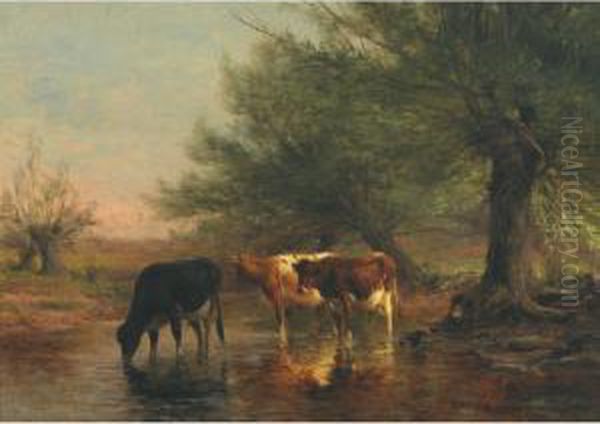
Craig worked during a dynamic period in American art. While he adhered to a more traditional, naturalistic style, he was contemporary with artists exploring new directions. The American Impressionists, such as Childe Hassam, J. Alden Weir, and Theodore Robinson, were capturing light and color in a different manner, influenced by French Impressionism. Tonalist painters like Ralph Albert Blakelock and Dwight William Tryon explored mood and atmosphere through subtle color harmonies, sharing some common ground with the Barbizon aesthetic that influenced Craig.
Major figures like Winslow Homer, though working in a distinct and powerful style, were also his contemporaries, depicting different facets of the American landscape and experience. Craig's continued success demonstrates the enduring appeal of representational landscape painting and pastoral themes alongside these emerging modern trends.
Final Years and Lasting Legacy
Thomas Bigelow Craig passed away in 1924 at his summer studio in Woodland, New York. He left behind a substantial body of work that had earned him considerable recognition and popularity during his lifetime. His legacy is that of a dedicated and skilled painter who captured a specific, idealized vision of the American rural landscape.
His paintings offered viewers, then as now, a sense of peace and stability, a connection to a gentle, agrarian world. He was a master of his chosen genre, consistently delivering well-crafted and atmospheric scenes that found a receptive audience.
Museum Collections and Enduring Appeal
Today, Thomas Bigelow Craig's paintings are held in the collections of numerous American museums, attesting to his historical significance. These institutions include the Pennsylvania Academy of the Fine Arts, the Metropolitan Museum of Art in New York, the Newark Museum, the Smithsonian American Art Museum in Washington D.C., the Philadelphia Museum of Art, and the Mobile Museum of Art, among others.
The enduring appeal of his work lies in its quiet beauty and technical proficiency. His paintings serve as windows onto a serene, sunlit version of the American past, chronicling the pastoral landscapes of Pennsylvania, New York, and New Jersey with affection and skill.
Conclusion
Thomas Bigelow Craig carved a distinct path in American art history. As a largely self-taught artist, he developed a mastery of landscape painting, specializing in tranquil pastoral scenes featuring cattle. Influenced by the atmospheric concerns of the Barbizon school while retaining the detailed observation associated with the Hudson River tradition, he created a body of work that was both popular in his time and remains appreciated today. His paintings stand as gentle, enduring depictions of the American countryside during a period of significant national transformation.